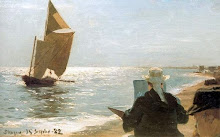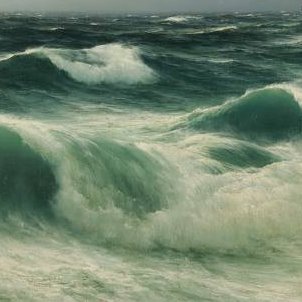His seascape palette included three blues: cobalt, ultramarine, and cerulean. Viridian green combined with cerulean blue produces the turquoises in his foreground waves. Cerulean and viridian are essential for capturing the hues of seawater. He added the cool red, Alizarin crimson, to his skies to suggest distant rosiness. He also included cadmium red and yellow in his palette, warm colors suitable for foreground rocks and sand; and burnt and raw sienna would have served for underpainting cliffs and rocks. Sea foam needs to be a bright and opaque white. He used "permalba" white and ivory black (a cool black tending towards blue, suitable for the sea).
I'm not sure what was in the permalba white manufactured in the early 20th century but on a painting forum I read that the permalba white in art shops today is not very opaque.
I'm not sure what was in the permalba white manufactured in the early 20th century but on a painting forum I read that the permalba white in art shops today is not very opaque.
Some books on F. Judd Waugh:

































No comments:
Post a Comment